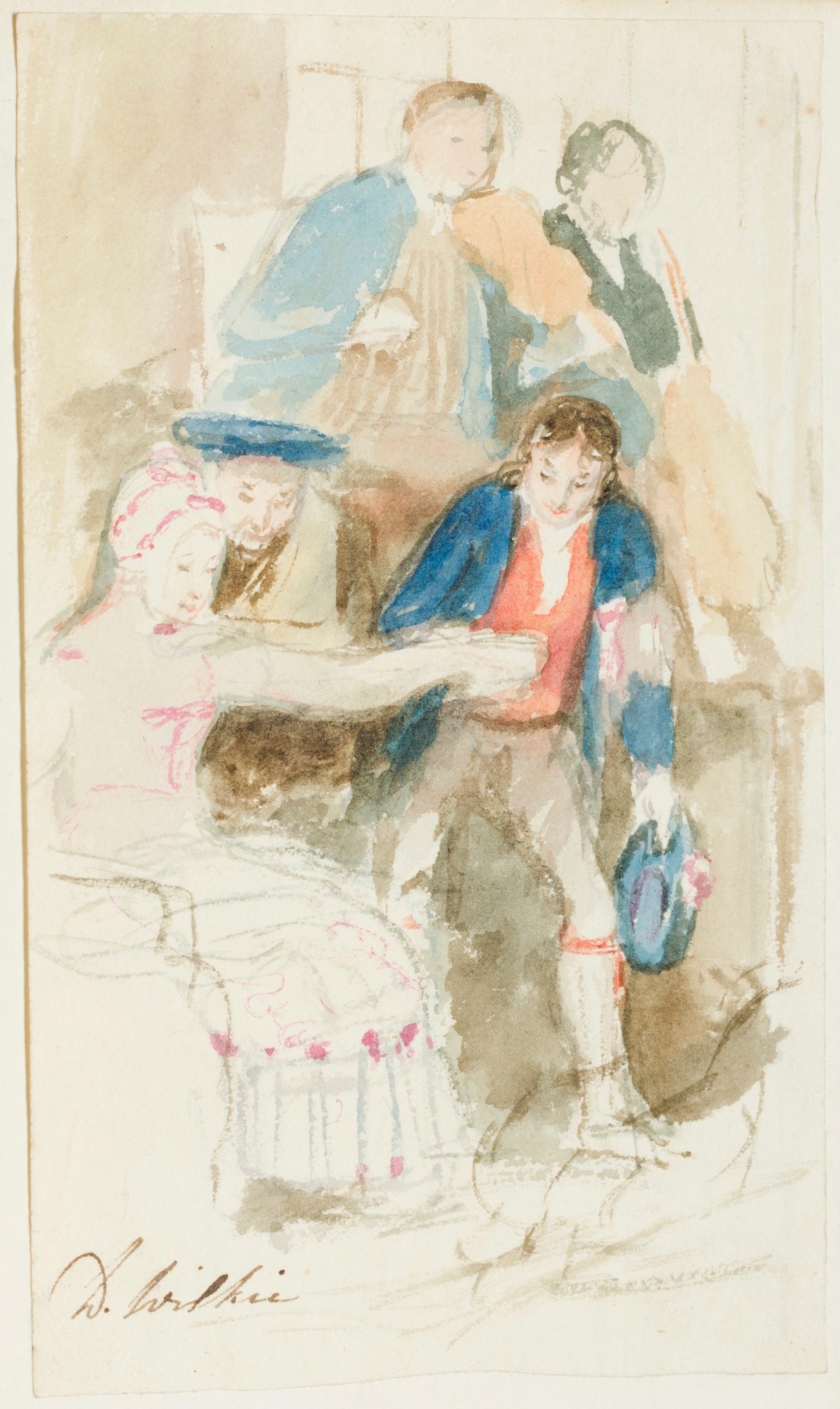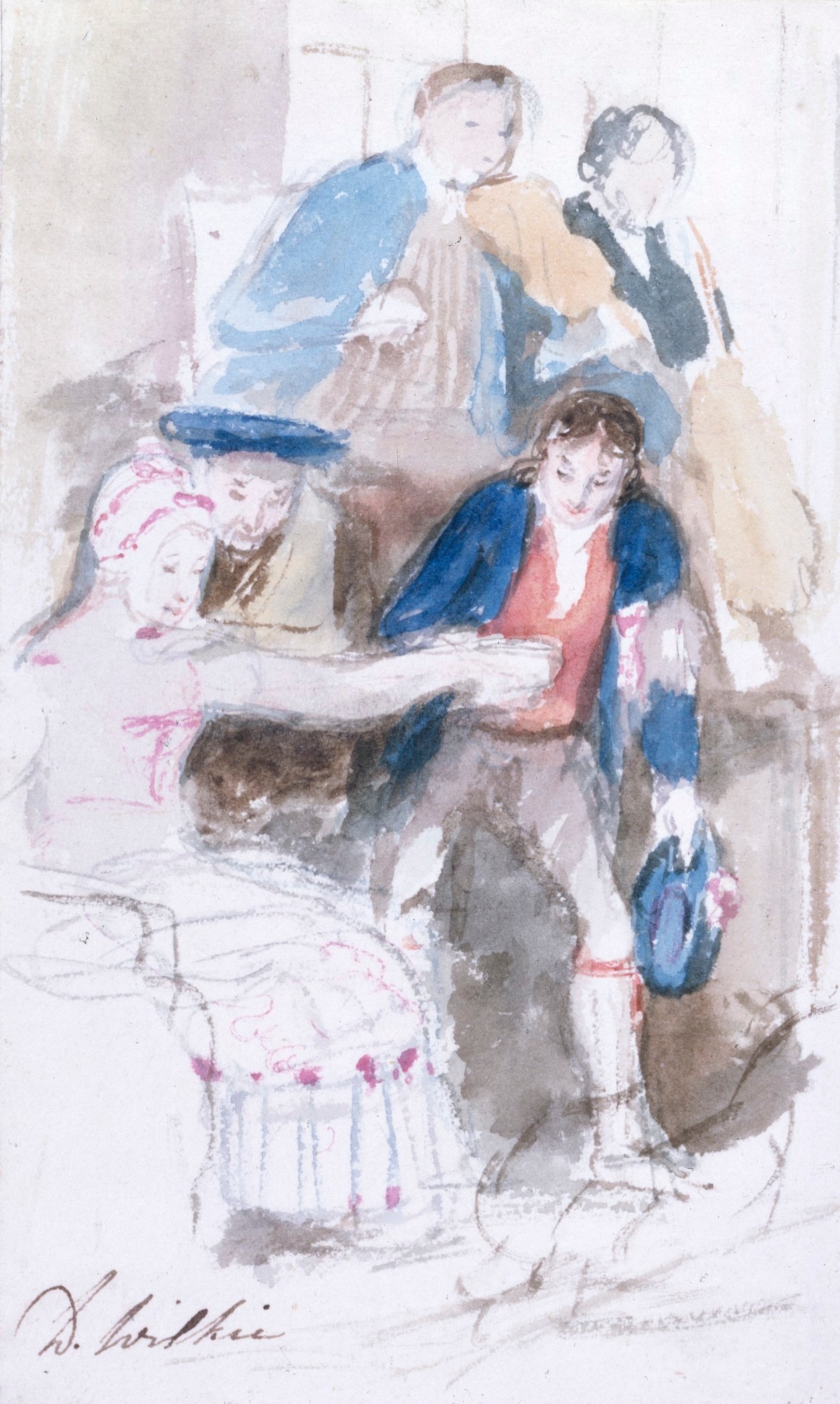
Sir David Wilkie RA, Study for 'The Penny Wedding', ca. 1818.
Pencil and watercolour on cream wove paper. 131 mm x 78 mm. © Photo: Royal Academy of Arts, London.
This image is released under Creative Commons CC-BY-NC-ND
To licence this image for commercial purposes, contact our Picture Library at picturelibrary@royalacademy.org.uk

Sir David Wilkie RA, Study for 'The Penny Wedding', ca. 1818.
Pencil and watercolour on cream wove paper. 131 mm x 78 mm. © Photo: Royal Academy of Arts, London.
This image is not available to download. To licence this image for commercial purposes, contact our Picture Library at picturelibrary@royalacademy.org.uk
Study for 'The Penny Wedding', ca. 1818
Sir David Wilkie RA (1785 - 1841)
RA Collection: Art
The Penny Wedding (Royal Collection), Wilkie's nostalgic depiction of a traditional Scottish wedding reception, was commissioned by George IV as a companion piece to Blind Man's Buff (Royal Collection). This delicately colourful sketch shows Wilkie experimenting with one of the complex figure groupings in the painting - the bridegroom gently exhorting the bride to join the dance. Here, she remains seated looking apprehensive, but urged on by another figure behind her. Wilkie rejected this version for the finished painting, instead portraying a more enthusiastic figure, already on her feet.
One of Scotland's most celebrated artists, David Wilkie made his name with lively genre paintings in the Dutch tradition. He studied in Edinburgh before moving to London and the Royal Academy Schools in 1805. Immediate success followed and his popularity reached its height with Chelsea Pensioners Reading the Gazette of the Battle of Waterloo (1818-22, Apsley House), which attracted such a throng of admirers at the Royal Academy that a barrier was needed to protect it.
In 1825 Wilkie suffered a nervous breakdown brought on by bereavement and overwork. Unable to paint he embarked on a Grand Tour that developed his interest in Italian and Spanish painting. The effect of these travels is displayed in his later work which became broader and more ambitious. Wilkie died in 1841 returning from the Middle East, an event commemorated by Turner in his sombre tribute Peace - Burial at Sea (1842, Tate Britain).
These drawings by Sir David Wilkie are all mounted in an album of studies probably put together by the artist's brother. According to the artist and Royal Academy librarian Solomon Hart 'they are a portion of a series of sketches of pictures, which he [Wilkie] from time to time sent to a brother, an officer in the Indian Army. He, it seems, used to give them to his brother-officers' children, who bedaubed them with common watercolours. Such as escaped I had the good fortune to acquire for the Academy, from a sister of some of these juvenile artists' (Alexander Brodie ed., The Reminiscences of Solomon Alexander Hart R.A., London, 1882, p.66)
Included in the album are sketches relating to some of Wilkie's best-known works including 'The Penny Wedding' (1818; Royal collection), 'The Breakfast' (1817; Private collection) and 'Chelsea Pensioners Reading the Gazette of the Battle of Waterloo' (1818-22, Apsley House).
This drawing relates to 'The Penny Wedding' (1818; Royal Collection), a painting commissioned from Sir David Wilkie by George IV as a companion piece to 'Blind Man’s Buff' (1812; Royal Collection). The subject is a nostalgic depiction of a traditional Scottish wedding c. 1770, at which guests donated a penny each to fund the festivities. It is a complex composition with many figure groupings which required the artist to produce numerous preparatory drawings, including these examples.
Wilkie's biographer, Allan Cunningham, described the composition of the finished painting:
'The manners and customs and character of old Scotland reign and triumph in it: the demure looks of the people, till music and liquor kindle them up; the mirth accompanied by decorum; the grave humour of the old, and the modest, nay bashful manners of the young, are stamped on every individual face and group, not in tartan, as painters of the South erroneously limn Scottish character... All the glee and modest joy of the elder poets of Scotland are in the picture of Wilkie with none of their lasciviousness, for the absence of which it is said that the Prince hardly forgave him, for he loved a joke which touched on the delicate line of decorum. To the composition of this picture the painter called all his knowledge of character and all his skill in expressing it; and it cannot be denied that it breathes with life throughout its length and breadth'.
Object details
131 mm x 78 mm
Start exploring the RA Collection
- Explore art works, paint-smeared palettes, scribbled letters and more...
- Artists and architects have run the RA for 250 years.
Our Collection is a record of them.



